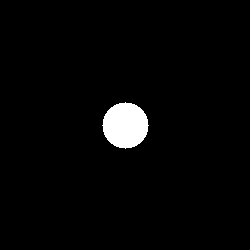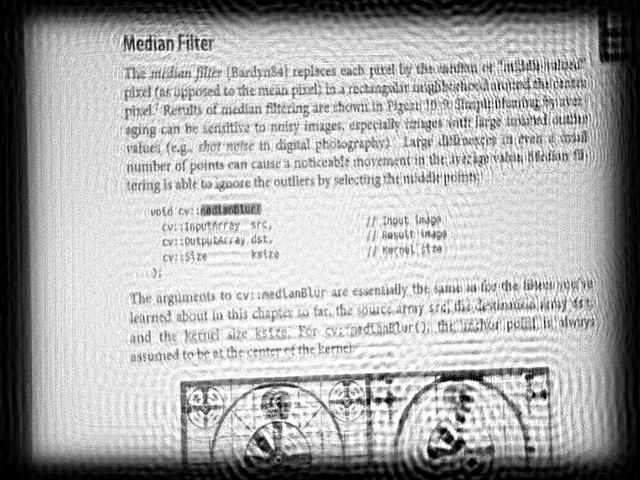Prev Tutorial: Image Segmentation with Distance Transform and Watershed Algorithm Next Tutorial: Motion Deblur Filter
Original author Karpushin Vladislav
Compatibility OpenCV >= 3.0
In this tutorial you will learn:
what a degradation image model is
what the PSF of an out-of-focus image is
how to restore a blurred image
what is a Wiener filter
Note The explanation is based on the books [109] and [329] . Also, you can refer to Matlab's tutorial Image Deblurring in Matlab and the article SmartDeblur .
The out-of-focus image on this page is a real world image. The out-of-focus was achieved manually by camera optics. Here is a mathematical model of the image degradation in frequency domain representation:
where is a spectrum of blurred (degraded) image, is a spectrum of original true (undegraded) image, is a frequency response of point spread function (PSF), is a spectrum of additive noise.
The circular PSF is a good approximation of out-of-focus distortion. Such a PSF is specified by only one parameter - radius . Circular PSF is used in this work.
Circular point spread function
The objective of restoration (deblurring) is to obtain an estimate of the original image. The restoration formula in frequency domain is:
where is the spectrum of estimation of original image , and is the restoration filter, for example, the Wiener filter.
The Wiener filter is a way to restore a blurred image. Let's suppose that the PSF is a real and symmetric signal, a power spectrum of the original true image and noise are not known, then a simplified Wiener formula is:
where is signal-to-noise ratio.
So, in order to recover an out-of-focus image by Wiener filter, it needs to know the and of the circular PSF.
You can find source code in the samples/cpp/tutorial_code/ImgProc/out_of_focus_deblur_filter/out_of_focus_deblur_filter.cpp of the OpenCV source code library.
#include <iostream>
void help();
void calcPSF(
Mat & outputImg,
Size filterSize,
int R);
void fftshift(
const Mat & inputImg,
Mat & outputImg);
void filter2DFreq(
const Mat & inputImg,
Mat & outputImg,
const Mat & H);
void calcWnrFilter(
const Mat & input_h_PSF,
Mat & output_G,
double nsr);
"{help h usage ? | | print this message }"
"{image |original.jpg | input image name }"
"{R |5 | radius }"
"{SNR |100 | signal to noise ratio}"
;
int main (
int argc,
char *argv[])
{
help();
if (parser.has("help" ))
{
parser.printMessage();
return 0;
}
int R = parser.get<int >("R" );
int snr = parser.get<int >("SNR" );
string strInFileName = parser.get<
String >(
"image" );
samples::addSamplesDataSearchSubDirectory("doc/tutorials/imgproc/out_of_focus_deblur_filter/images" );
if (!parser.check())
{
parser.printErrors();
return 0;
}
imgIn = imread(samples::findFile( strInFileName ), IMREAD_GRAYSCALE);
{
cout << "ERROR : Image cannot be loaded..!!" << endl;
return -1;
}
calcPSF(h, roi.
size (), R);
calcWnrFilter(h, Hw, 1.0 / double (snr));
filter2DFreq(imgIn(roi), imgOut, Hw);
normalize(imgOut, imgOut, 0, 255, NORM_MINMAX);
imshow("Original" , imgIn);
imshow("Debluring" , imgOut);
imwrite("result.jpg" , imgOut);
waitKey(0);
return 0;
}
void help()
{
cout << "2018-07-12" << endl;
cout << "DeBlur_v8" << endl;
cout << "You will learn how to recover an out-of-focus image by Wiener filter" << endl;
}
void calcPSF(
Mat & outputImg,
Size filterSize,
int R)
{
circle (h, point, R, 255, -1, 8);
outputImg = h / summa[0];
}
void fftshift(
const Mat & inputImg,
Mat & outputImg)
{
outputImg = inputImg.
clone ();
int cx = outputImg.
cols / 2;
int cy = outputImg.
rows / 2;
Mat q0(outputImg,
Rect (0, 0, cx, cy));
Mat q1(outputImg,
Rect (cx, 0, cx, cy));
Mat q2(outputImg,
Rect (0, cy, cx, cy));
Mat q3(outputImg,
Rect (cx, cy, cx, cy));
q3.copyTo(q0);
q1.copyTo(tmp);
q2.copyTo(q1);
}
void filter2DFreq(
const Mat & inputImg,
Mat & outputImg,
const Mat & H)
{
merge (planes, 2, complexI);
dft (complexI, complexI, DFT_SCALE);
merge (planesH, 2, complexH);
idft (complexIH, complexIH);
split (complexIH, planes);
outputImg = planes[0];
}
void calcWnrFilter(
const Mat & input_h_PSF,
Mat & output_G,
double nsr)
{
fftshift(input_h_PSF, h_PSF_shifted);
merge (planes, 2, complexI);
pow(abs(planes[0]), 2, denom);
denom += nsr;
divide (planes[0], denom, output_G);
}
Designed for command line parsing.
Definition utility.hpp:890
Template matrix class derived from Mat.
Definition mat.hpp:2257
n-dimensional dense array class
Definition mat.hpp:830
CV_NODISCARD_STD Mat clone() const
Creates a full copy of the array and the underlying data.
MatSize size
Definition mat.hpp:2187
void copyTo(OutputArray m) const
Copies the matrix to another one.
int cols
Definition mat.hpp:2165
bool empty() const
Returns true if the array has no elements.
int rows
the number of rows and columns or (-1, -1) when the matrix has more than 2 dimensions
Definition mat.hpp:2165
void convertTo(OutputArray m, int rtype, double alpha=1, double beta=0) const
Converts an array to another data type with optional scaling.
Template class for 2D rectangles.
Definition types.hpp:444
Size_< _Tp > size() const
size (width, height) of the rectangle
Template class for specifying the size of an image or rectangle.
Definition types.hpp:335
_Tp height
the height
Definition types.hpp:363
_Tp width
the width
Definition types.hpp:362
void split(const Mat &src, Mat *mvbegin)
Divides a multi-channel array into several single-channel arrays.
void mulSpectrums(InputArray a, InputArray b, OutputArray c, int flags, bool conjB=false)
Performs the per-element multiplication of two Fourier spectrums.
void divide(InputArray src1, InputArray src2, OutputArray dst, double scale=1, int dtype=-1)
Performs per-element division of two arrays or a scalar by an array.
Scalar sum(InputArray src)
Calculates the sum of array elements.
void merge(const Mat *mv, size_t count, OutputArray dst)
Creates one multi-channel array out of several single-channel ones.
void idft(InputArray src, OutputArray dst, int flags=0, int nonzeroRows=0)
Calculates the inverse Discrete Fourier Transform of a 1D or 2D array.
void dft(InputArray src, OutputArray dst, int flags=0, int nonzeroRows=0)
Performs a forward or inverse Discrete Fourier transform of a 1D or 2D floating-point array.
std::string String
Definition cvstd.hpp:151
#define CV_8U
Definition interface.h:73
#define CV_32F
Definition interface.h:78
@ circle
Definition gr_skig.hpp:62
int main(int argc, char *argv[])
Definition highgui_qt.cpp:3
An out-of-focus image recovering algorithm consists of PSF generation, Wiener filter generation and filtering a blurred image in frequency domain:
calcPSF(h, roi.
size (), R);
calcWnrFilter(h, Hw, 1.0 / double (snr));
filter2DFreq(imgIn(roi), imgOut, Hw);
A function calcPSF() forms a circular PSF according to input parameter radius :
void calcPSF(
Mat & outputImg,
Size filterSize,
int R)
{
circle (h, point, R, 255, -1, 8);
outputImg = h / summa[0];
}
A function calcWnrFilter() synthesizes the simplified Wiener filter according to the formula described above:
void calcWnrFilter(
const Mat & input_h_PSF,
Mat & output_G,
double nsr)
{
fftshift(input_h_PSF, h_PSF_shifted);
merge (planes, 2, complexI);
pow(abs(planes[0]), 2, denom);
denom += nsr;
divide (planes[0], denom, output_G);
}
A function fftshift() rearranges the PSF. This code was just copied from the tutorial Discrete Fourier Transform :
void fftshift(
const Mat & inputImg,
Mat & outputImg)
{
outputImg = inputImg.
clone ();
int cx = outputImg.
cols / 2;
int cy = outputImg.
rows / 2;
Mat q0(outputImg,
Rect (0, 0, cx, cy));
Mat q1(outputImg,
Rect (cx, 0, cx, cy));
Mat q2(outputImg,
Rect (0, cy, cx, cy));
Mat q3(outputImg,
Rect (cx, cy, cx, cy));
q3.copyTo(q0);
q1.copyTo(tmp);
q2.copyTo(q1);
}
A function filter2DFreq() filters the blurred image in the frequency domain:
void filter2DFreq(
const Mat & inputImg,
Mat & outputImg,
const Mat & H)
{
merge (planes, 2, complexI);
dft (complexI, complexI, DFT_SCALE);
merge (planesH, 2, complexH);
idft (complexIH, complexIH);
split (complexIH, planes);
outputImg = planes[0];
}
Below you can see the real out-of-focus image:
And the following result has been computed with = 53 and = 5200 parameters:
The Wiener filter was used, and values of and were selected manually to give the best possible visual result. We can see that the result is not perfect, but it gives us a hint to the image's content. With some difficulty, the text is readable.
Note The parameter is the most important. So you should adjust first, then .
Sometimes you can observe the ringing effect in a restored image. This effect can be reduced with several methods. For example, you can taper input image edges. You can also find a quick video demonstration of this on YouTube .
VIDEO




